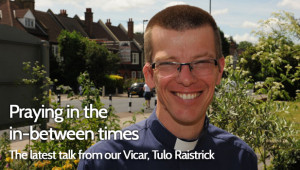John 20:1-18
Easter Sunday 9.04.2023
Sunrise Service
Rev Jeremy Bevan
There’s a first time for everything, as the saying goes. And having made my way while it was
still dark to my first ever Easter Sunday dawn service this morning, I have a new
appreciation for the devotion of Mary Magdalene to Jesus.
In John’s Gospel, she appears for the first time by name at the cross as Jesus is crucified. The
other gospel writers variously describe her as a woman of financial means, one of those who
supported Jesus’s ministry; and as a woman Jesus had healed, from whom he had exorcised
seven demons, perhaps a reference to mental ill-health. Whatever it was, Jesus seems to
have called forth from Mary an intense devotion that would lead her to take risks. We at
least had streetlights to guide us here before dawn this morning, but pre-dawn Jerusalem in
Mary’s time would have been pitch-dark, and possibly unsafe for women. Despite that, she
goes to the tomb, maybe intending simply to sit with the corpse, or perhaps to anoint it,
though in John’s Gospel at least, others have already done this.
Imagine her distress, then, on finding the tomb broken open and empty. Imagine: the one
person who helped put your life back together, revived you, is gone, victim of brutal, judicial
murder. You hope to be allowed time and space to mourn that person in a dignified way
only for criminals (it seems) to rob you of that opportunity. In a world turned upside-down,
Mary quite understandably just wants a reassuring return to things as they used to be.
She is determined: not easily deterred on her mission to get back the Jesus she knew and
loved so much, to restore some post-mortem dignity to his memory. While Peter and the
beloved disciple (probably John) sift the tomb’s evidence for clues, Mary watches on,
weeping for what looks like irretrievable loss. For us, the equivalent at this moment in the
gospel account might be losing every single precious photo we had of a loved one to a fire
or theft, our memories of them blighted forever.
But in her distress, Mary is about to undergo a most remarkable transformation, though it
will take encounters with two angels and someone she thinks is the gardener to kickstart it.
As she starts again with Jesus, where is she? In a garden. Are there parallels here to the
garden of Eden? There are two angels in the tomb. In Eden, heavenly being barred the way
back to paradise. In Mary’s garden, the two suggest it may be time for the hard edge of
sorrow at what has been to soften in the light of what is to come. But still she wants ‘the
gardener’ to end her torment by giving her the body back, allowing her to go back.
In Eden, when God calls Adam and Eve, they hide. In Mary’s garden, moving forward begins
when Jesus calls Mary by name. This is a hugely symbolic moment. When God’s love reaches
out to us through Jesus’ sacrifice on the cross and his resurrection, it’s never less than a
deeply and fully personal moment, drawing in all that we have and all that we are, all our
teers at whatever losses we, like Mary, mourn. And then comes that moment to move
forward with Jesus, for Mary and for us. That’s why, I think, he gently tells her not to cling to
him, not to try and fix him as an unchanging memory, but to let him take her, as he wants to
take us, into his unconstrained future.
How instructive for us if we’re tempted to think we have Jesus in a box, God as someone we
can always predict and manage. As Jesus ascends to God his Father and the Father of Mary
and of all the disciples, it falls to her to be the first evangelist of the good news emanating
from a second Eden-like garden. Jesus is alive. How might we respond to Jesus who is not in
a box, not entombed? At Ely Cathedral, there’s a marvellous sculpture that captures the
moment Jesus says to Mary “let me go.” She’s not clinging to him, but dancing around him.
How very appropriate for this Eastertide: like Mary, revived once more by the love that calls
each of us by name, shall we prepare for a future with the Risen One, and dance where his
love leads?

